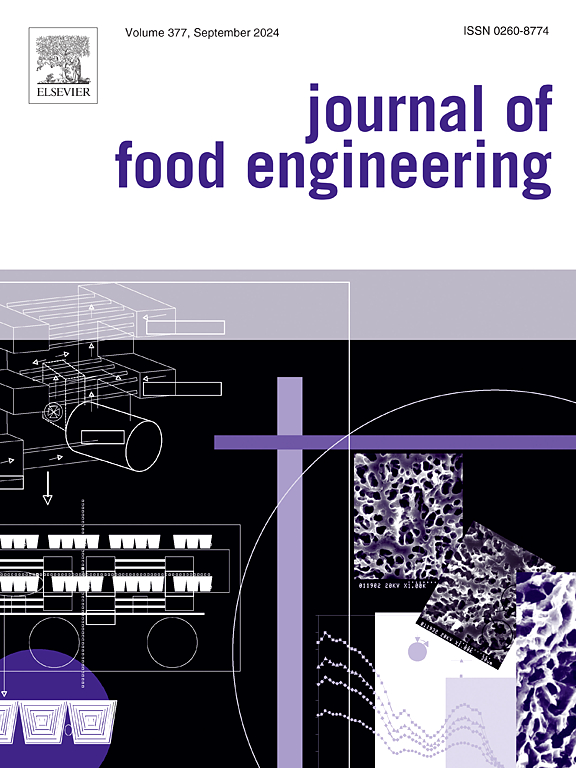Novel feature extraction in laser light backscattering imaging for real-time monitoring of quince moisture content during hot-air drying
IF 5.3
2区 农林科学
Q1 ENGINEERING, CHEMICAL
引用次数: 0
Abstract
Non-contact and accurate determination of product moisture content during drying is essential for maintaining quality and evaluating drying performance. In this study, a specific drying chamber was equipped with a laser light backscattering imaging (LLBI) setup to capture real-time backscattering images of quince slices. Two diode-pumped lasers, operating at green (532 nm) and near-infrared (NIR) (980 nm) wavelengths, were implemented for this purpose. In addition to extracting color features from backscattered regions, state-of-the-art shape features were also extracted from both saturated and backscattered regions of the lasers by measuring radial profiles (RPs). Furthermore, two pre-trained convolutional neural networks, namely ResNet50 and VGG19, were utilized to extract new deep features. The color and shape features of both lasers were assessed individually and in a fusion strategy to maximize the predictability of moisture content using two regression methods: partial least squares (PLS) and artificial neural networks (ANN). The results demonstrated excellent predictability of moisture content when color and shape features of the green laser were fused into an ANN model (SDR of 3.00). However, the NIR laser yielded moderate predictions individually, particularly when utilizing VGG19 deep features (SDR of 2.08). Moreover, the fusion of color and shape features from both lasers exhibited strong synergy, resulting in the best ANN predictive model (R2p of 0.920, RMSEP of 7.24%, and SDR of 3.56). Through the utilization of these novel features, this study highlights the significant potential of the LLBI technique for real-time monitoring of moisture content in quince slices during drying.
基于激光后向散射成像的木瓜热风干燥水分实时监测新方法
干燥过程中产品水分含量的非接触式准确测定对于保持干燥质量和评价干燥性能至关重要。本研究在特定的干燥室内安装了激光后向散射成像(LLBI)装置,以实时捕获榅桲片的后向散射图像。为此,实现了两个二极管泵浦激光器,分别工作在绿光(532 nm)和近红外(NIR) (980 nm)波长。除了从后向散射区域提取颜色特征外,还通过测量径向轮廓(RPs)从激光器的饱和和后向散射区域提取了最先进的形状特征。此外,利用两个预训练的卷积神经网络ResNet50和VGG19提取新的深度特征。分别评估了两种激光器的颜色和形状特征,并采用融合策略,使用两种回归方法:偏最小二乘法(PLS)和人工神经网络(ANN)来最大化水分含量的可预测性。结果表明,将绿色激光的颜色和形状特征融合到一个人工神经网络模型(SDR为3.00)中,可以很好地预测水分含量。然而,近红外激光单独产生了中等的预测,特别是当利用VGG19深度特征(SDR为2.08)时。此外,两种激光的颜色和形状特征融合表现出较强的协同作用,得到了最佳的人工神经网络预测模型(R2p为0.920,RMSEP为7.24%,SDR为3.56)。通过利用这些新特性,本研究突出了LLBI技术在干燥过程中实时监测榅桲片水分含量的巨大潜力。
本文章由计算机程序翻译,如有差异,请以英文原文为准。
求助全文
约1分钟内获得全文
求助全文
来源期刊

Journal of Food Engineering
工程技术-工程:化工
CiteScore
11.80
自引率
5.50%
发文量
275
审稿时长
24 days
期刊介绍:
The journal publishes original research and review papers on any subject at the interface between food and engineering, particularly those of relevance to industry, including:
Engineering properties of foods, food physics and physical chemistry; processing, measurement, control, packaging, storage and distribution; engineering aspects of the design and production of novel foods and of food service and catering; design and operation of food processes, plant and equipment; economics of food engineering, including the economics of alternative processes.
Accounts of food engineering achievements are of particular value.
 求助内容:
求助内容: 应助结果提醒方式:
应助结果提醒方式:


